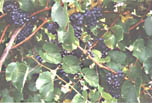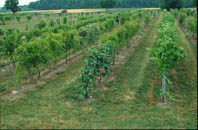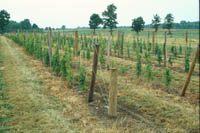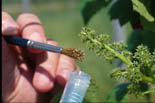
Objective
Establishment of a
"No Spray" Vineyard
Crossing of Disease Resistant Selections
Identification of Disease Resistant Germplasm
Table 1. Average Leaf Disease Ratings 1992-2000

Breeding of Disease Resistant Grape Varieties in New York
Objective: Breeding for disease and insect resistance has been a long-standing goal of grape breeders. Although some interspecific hybrids and "native varieties" are said to be pest resistant, most still require regular pest control programs to maintain crop quality and vine health. By contrast, wild grapevine species growing under natural conditions sometimes appear to be virtually free of pests and disease. While pest resistance of wild species may be high, fruit quality is low. Wild berries are usually small, have high acidity and undesirable flavors. Our goal has been to identify highly disease resistant wild vines and to cross them with "quality" parents. Seedlings are then selected under "fungicide- and insecticide-free" conditions to develop new high quality, disease resistant cultivars.
|
Disease resistance breeding research vineyard
|
Establishment of a "No-Spray" Vineyard: In 1991, the first vines were established in a "no-spray" vineyard. New rows have been added each year. The vineyard was split into two blocks: a seedling or "first test" block to evaluate new seedling populations, and a "second test" block to evaluate selections and species. Conventional vineyard practices of pruning, training, suckering, weed control, and fertilization have been maintained, however, no fungicide or insecticide applications have been made since establishment. The cultivars 'Concord', 'Steuben' and 'Chancellor' have been planted as standards throughout the vineyard to evaluate the uniformity of disease infection and for comparison of disease reactions with known checks. Yearly observations at this site have included: trunk injury, vine vigor, and crop load, as well as disease ratings of leaves and fruit. Insect damage has also been noted when severe.
Click on images to view at full size.
|
Pollinating clusters - pollen is applied using a clean brush |
Crossing of Disease Resistant Selections: Our primary goal is to produce varieties with high fruit quality that can be grown without pesticide use. That being the case, a large number of crosses are made annually with the intent of using quality parents to improve the fruit characteristics of the more wild disease resistant parents. In addition, some crosses are made for the longer term goals of strengthening the disease resistant potential of parental material by crossing between different sources of resistance. Crosses have generally fallen into 3 categories:
1. Highly disease resistant x Vitis vinifera
2. Highly disease resistant x high quality interspecific hybrids
3. Highly disease resistant x highly disease resistant (different sources)



